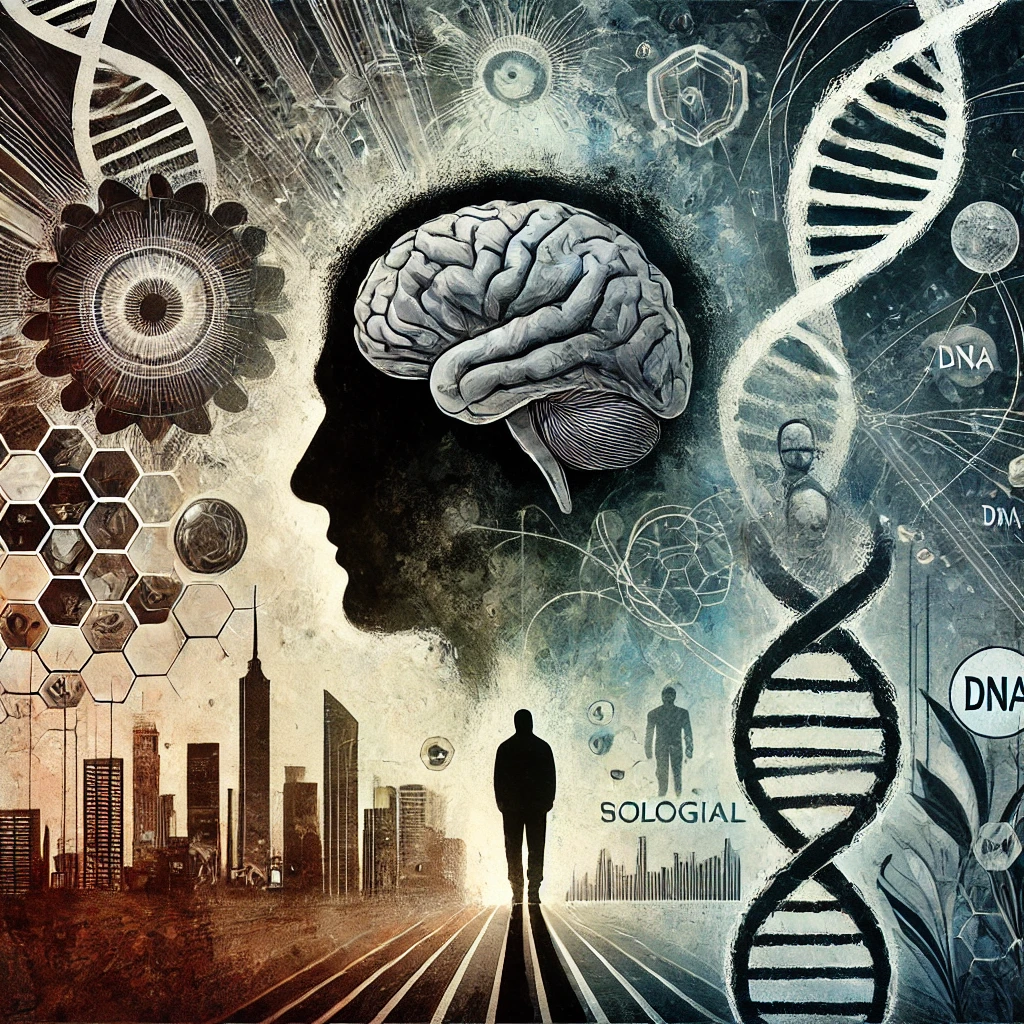Introduction
Crime is not merely an act that violates social norms but a complex phenomenon deeply intertwined with psychological, biological, and social factors. Understanding it requires an in-depth exploration of human behavior and environmental influences.
Researchers categorize the factors leading to criminal behavior into two main types: individual factors, which stem from the individual’s innate and acquired traits, and external factors, which involve natural and social environmental influences. This article delves into these factors in detail, shedding light on the insights of prominent thinkers who have significantly contributed to this field.
Section One: Individual Factors
Individual factors refer to internal traits and conditions that influence a person’s propensity for criminal behavior. These factors are divided into two main categories: intrinsic internal factors and acquired internal factors.
Part One: Intrinsic Internal Factors
1. Genes, Heredity, and Their Impact on Criminal Behavior
The field of genetics was among the first to explore the connection between hereditary traits and criminal behavior.
- Direct Genetic Influence: Researchers suggest that certain genetic traits may increase the likelihood of aggressive behavior, such as a predisposition to poor anger management.
- Twin Studies: Studies on identical twins (who share 100% of their genetic material) have shown that if one twin commits a crime, the other twin has a higher likelihood of criminal behavior compared to fraternal twins.
2. Intelligence and Cognitive Abilities as Influential Factors
The level of intelligence is closely linked to criminal behavior through its effect on an individual’s ability to make informed decisions and avoid risks.
- Individuals with lower intelligence levels often lack critical thinking and problem-solving skills, making them more prone to committing impulsive crimes.
- A notable study found that low emotional intelligence (EQ) increases aggressive behaviors, as individuals struggle to understand others’ emotions.
3. Psychological and Mental Disorders
Psychological disorders play a significant role in explaining the inclination of some individuals toward crime.
- Antisocial Personality Disorder (ASPD): Characterized by a disregard for the rights of others and societal norms, along with a lack of remorse.
- Other Mental Disorders: Conditions such as schizophrenia (associated with hallucinations and delusions) and mood disorders can drive individuals toward aggressive behavior as a means of expressing frustration.
Part Two: Acquired Internal Factors
1. The Influence of Upbringing and Early Experiences
Upbringing forms the foundation of an individual’s personality.
- Troubled Childhood: Individuals who experience violent or emotionally neglectful childhoods often develop aggressive tendencies as a result of these experiences.
- Negative Role Models: Children raised in environments that normalize deviant behavior adopt these patterns as natural responses to challenges.
2. Addiction to Drugs and Alcohol
Substance abuse is one of the most significant factors contributing to criminal behavior.
- Addiction and Crime: Addicts often commit crimes, such as theft, to finance their substance dependence.
- Brain Chemistry Alteration: Drugs disrupt brain chemistry, impairing logical decision-making and increasing aggressive tendencies.
3. Psychological Trauma and Its Aftermath
- Wars and Disasters: Individuals living in war-torn areas or affected by natural disasters may develop aggressive patterns as coping mechanisms.
- Personal Traumas: Experiences such as physical or sexual assault leave lasting impacts that often manifest in criminal behaviors later in life.

Section Two: External Criminal Factors
External factors encompass all aspects of the natural and social environment that influence an individual’s behavior directly or indirectly.
Part One: Natural Factors
1. The Impact of Climate and Weather on Crime
Research indicates that climatic conditions play a role in crime rates.
- Hot Seasons: Crime rates tend to rise during hotter seasons due to increased tension and irritability.
- Natural Disasters: Events like earthquakes or floods can lead to crimes such as looting and assaults amid societal breakdowns.
2. Geographical Location and Its Effect on Criminal Behavior
- Urban Areas: Large cities report higher crime rates due to population density and economic disparity.
- Rural Areas: While crime rates may be lower, the nature of offenses often revolves around disputes over resources.
Part Two: Social Factors
1. Poverty and Unemployment as Major Drivers
Poverty serves as one of the primary drivers of crime, especially when individuals fail to meet their basic needs.
- Economic Theories: Robert Merton’s theory suggests that the disparity between an individual’s material goals and their means of achieving them drives deviance.
- Unemployment fosters frustration, pushing individuals toward unlawful methods of survival.
2. The Role of Family and Social Relationships
- Domestic Violence: Families plagued by violence often produce individuals more prone to criminal behavior.
- Peer Influence: Associating with deviant social groups amplifies criminal tendencies.
3. Subcultures and Deviant Groups
- Gangs provide psychological and social support to deviant individuals, making it challenging to leave the criminal path.
- Certain subcultures glorify violent behavior, encouraging its spread.
Conclusion
Criminal behavior is not the result of a single factor but rather a complex interaction between the individual and their environment. By understanding the various contributing factors, we can develop effective policies aimed at crime prevention and social justice.
Continuous scientific research in this area remains crucial for creating innovative and sustainable solutions to this phenomenon.

